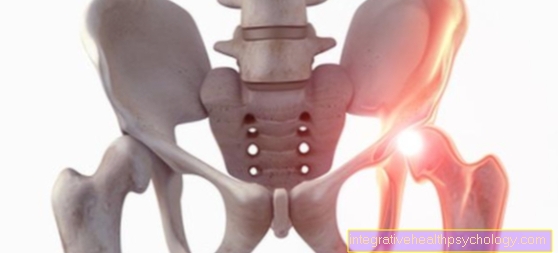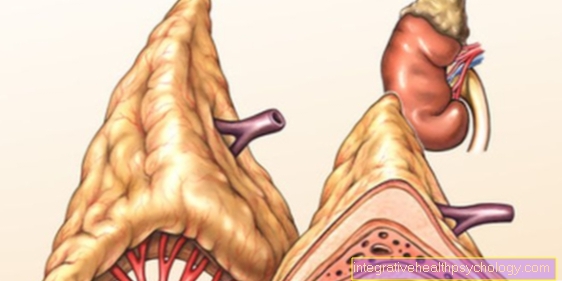Paratyphoid
definition
Paratyphoid is an infectious disease that is caused by a specific type of Salmonella bacteria.
Above all, there are digestive tract disorders with severe diarrhea, abdominal pain, nausea and vomiting. Mild fever and rashes are rare.
Diagnosis is based on the pathogen detection in blood and stool samples. Treatment consists of giving antibiotics that fight salmonella.
Paratyphoid is similar to typhoid, but occurs much less often and is usually milder.

I recognize paratyphoid by these symptoms
Paratyphoid fever shows the first signs 1-10 days after being infected with the pathogen. First there is a slight fever and pain in the head and joints. Often those affected also have a pronounced feeling of exhaustion and are tired.
After these first, slight signs, the stronger symptoms appear about 2 days later. The digestive tract is particularly affected. Diarrhea typically occurs. In addition, there is the feeling of nausea that is occasionally accompanied by vomiting. Those affected often have abdominal pain. The fever rises to a maximum of 39 ° C in the course of the illness, and body temperature is rarely higher.
The symptoms subside after a while. The illness usually lasts between 4 and 10 days.
Compared to the more common and better known typhoid fever, paratyphoid fever is significantly milder. Symptoms are similar but are rarely severe. The occurrence of complications is largely unknown, but cannot be ruled out if the immune system is weakened.
What is the difference to typhus?
Paratyphoid, just like typhoid, is transmitted by salmonella bacteria. Here, however, the subspecies of Salmonella differ depending on the disease. Furthermore, the many symptoms of paratyphoid disease are usually less pronounced.
The rash and the typhoid tongue, which occur more frequently in typhoid fever, do not or hardly occur in the clinical picture of paratyphoid fever. Only the diarrhea is usually more pronounced in paratyphoid fever.
Course of disease
The course of paratyphoid fever is usually quite mild. In contrast to typhoid fever, which is often more severe, the symptoms of paratyphoid fever are often only mild. The fever is usually no more than 39 ° C. The digestive tract is particularly affected, which manifests itself in diarrhea, nausea and vomiting. Apart from that, however, other symptoms rarely occur. The disease usually does not last longer than 10 days and usually heals again without any long-term effects.
therapy
Since the paratyphoid disease is triggered by bacteria, the therapy consists primarily in the administration of antibiotics. This means that Salmonella can be effectively combated. The preferred antibiotic is Ciprofloxacin. In the event of intolerance, the antibiotic ofloxacin can also be given as an alternative. Typically, depending on the severity of symptoms, the drug must be taken for 10 to 14 days. Occasionally, an antibiotic does not work well enough. The reason for this can, for example, be a resistance of the pathogen to the drug. In order to rule out the presence of such resistance, a test should be carried out beforehand to determine it. If there is resistance to ciprofloxacin or ofloxacin, e.g. the antibiotic Ceftriaxone are given.
In addition, depending on the body temperature, you should possibly use antipyretic drugs such as Paracetamol, are given. The salmonella that cause paratyphoid fever live inside the body's cells. Therefore, it usually takes a few days for the antipyretic drugs to take effect. In addition, care should be taken to ensure that there is sufficient fluid intake, as the body loses a lot of water through diarrhea.
How contagious is paratyphoid?
The infection can take place both directly, i.e. transmitted from person to person, or indirectly, e.g. by taking in contaminated food.
The direct route is mainly via the so-called fecal-oral mode of transmission. When a person gets paratyphoid, he excretes the salmonella in the stool. This allows other people to come into contact with the contagious pathogens, for example in hospitals.
In contrast to this, the indirect route includes the ingestion of contaminated food or drinking water that has been colonized with pathogens. The species of salmonella that causes paratyphoid has also been found sporadically in cattle and chickens, which poses a risk of being transmitted through food.
So there are a few ways that paratyphoid fever can be transmitted. The risk of infection is relatively high during an epidemic.
However, it should be noted that this disease is very rare. The countries where paratyphoid fever is common are mainly India, Pakistan and Turkey.
After suffering from illness, the person affected is relatively immune to the pathogen for about a year. However, a high number of bacteria can trigger another disease within this year.
causes
Paratyphus is an infectious disease that is transmitted and triggered by a pathogen. This pathogen is a specific type of Salmonella bacteria (Salmonella paratyphi) that can be transmitted in a number of ways.
This includes ingesting contaminated food or drinking contaminated water. However, the bacteria can also be transmitted from person to person.
When salmonella enters the body, they can attack various structures of the immune system, especially in the digestive tract, and thus trigger the disease.
What is the transmission route of paratyphoid fever?
The salmonella that cause paratyphoid fever can be transmitted in two ways.
Sick people excrete the bacteria in their stool. This allows direct transmission from person to person, for example in a hospital.
Indirect transmission is also possible. This occurs via contaminated drinking water or contaminated food. The Salmonella enter the body through the ingestion of the contaminated products.
However, it also takes a certain amount of bacteria to trigger the disease in the first place.
diagnosis
The diagnosis of paratyphoid fever is primarily made by detecting the pathogen in a sample of blood and stool.
Both the bacteria themselves and antibodies that the body has formed to defend itself against salmonella can be detected here.
Typical changes can be seen in the blood of those affected. These include a reduced number of white blood cells.
In addition, there is the anamnesis, i.e. the doctor-patient conversation, from which information can be derived, for example about contact with contaminated food or a trip to a risk country.
vaccination
There is currently no vaccination against paratyphoid fever.
It is therefore important that hygienic measures are observed when traveling to a risk country. The risk countries include the Balkans, India, Turkey and Pakistan. In order to avoid infection through contaminated food, care should be taken to ensure that no raw or insufficiently heated food is consumed.
In case of doubt, you can use the well-known saying "peel it, cook it or forget it!"
Forecast and durationThe symptoms of paratyphoid fever usually appear about 1 to 10 days after infection. They are usually relatively mild and the disease is usually over after another 4 to 10 days.
Since the infectious disease is self-limiting, it depends on the strength of the immune system, which determines, so to speak, how long the symptoms last.
The prognosis for paratyphoid fever is usually very favorable. Symptoms usually do not leave long-term damage and complications are rare.





























